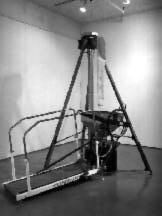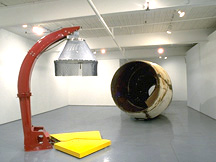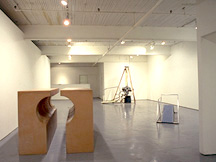- MAIN INDEX | ARTIST INDEX
| October 13 - November 7, 1987 Mowry Baden Curated by André Jodoin | |
 Mowry Baden, "Chickenfeed", 1984, wood, steel, aluminium, rubber, chickenfeed, Photo Peter MacCallum. 18K | |
 Mowry Baden, "Lariat Calais", 1987, steel, aluminum, plastic, 204x135x105"h. Photo Peter MacCallum. 18K |  Mowry Baden, "Task-Oriented Sculpture", 1987, installation view. Photo Peter MacCallum. 18K |
| Press Release Mowry Baden has been producing experimental work in the area of sculpture since 1965. Baden is perhaps best known for his 'envelope spaces', a genre which he describes as "alternative spaces that function within the confines of a conventional gallery yet envelope the visitor in a self-contained structure". The 'envelope spaces' maintain a separate and distinct environment, allowing the gallery viewer to focus on his or her sensory perception. These are built to direct movement through the gallery while producing physical stress and emphasizing specific 'gaps' between visusal and tactile perception. The upcoming exhibition will present a group of sculptures which appear similar to pieces of equipment and machines. Exhibition curator Andre Jodoin has proposed that these works belong to one class of production which he calls "task-oriented", a term used here to evoke associations with a variety of physical activities, such as walking, crawling, lifting, stretching, manouvering, etc. All of Baden's sculptures share a primary concern for the viewer as a moving participant. In the catalogue accompanying the exhibition, Jodoin examines the modernist belief in sculpture as an autonomous visual object located in idealized space, countering this notion by another idea equally modernist--sculpture as a palpable, sensory, motile subject. Mowry Baden lives and works in Victoria, B.C. Since 1957 he has exhibited extensively throughout Western Canada and the United States; however this exhibition at Mercer Union is the artist's first in Toronto. Recent exhibitions include the group exhibition Pluralities at the National Gallery of Canada ( 1980), an outdoor exhibition at Art Space, New York City ( 1984), and solo exhibitions at the Walter Phillips Gallery, Banff ( 1984) and the Art Gallery of Greater Victoria, B.C. (1985).
Catalogue Text:
Task-Oriented Sculptures
Mowry Baden's art proceeds on the basis of a theory of the body and perception. His sculptures resemble types of technical apparatus used, for instance, by scientific agencies for various kinds of testing. Jack Burnham has noted that Baden's sculptures are "limited environmental systems, considerably less complicated technically, but akin to the life-support simulations used in space programs" In general terms, technology may be defined as an organised body of knowledge which is applied systematically to practical tasks by means of technical equipment. I am therefore proposing that Baden's task-oriented sculptures, as identified in the previous section, are "technological" in effect. In what follows I will first discuss with reference to Baden's writings, the technological effect of his sculptures as a "testing" process and then go on to discuss how the sculptures reveal technical equipment as such through their special character as art works. In the latter part of this section Baden's sculptures will also be discussed in terms of their ability to disclose "things" Baden bases his theory of the body and perception on a philosophical self-report:
He is primarily concerned about gaps in perception:
Disjunctions between what we see and what we sense tactily and kinesthetically are apparent only when we are alert to them as they occur over time.
Example: In 1967 Baden constructed Phantom Limb, two cast polyester shells, conforming exactly to the dimensions of the artist's body (shoulder to shoulder 18", top of head to collarbone 10-3/4", shoulder to elbow 26", hip to hip 14", and ear to ear 6-1/2"). The two shells form a passage through which the artist moves: The result is a sculpture which aids in testing the senses, in mapping that region where perception and motility interpenetrate: My perceptual mechanisms quarrel - that is art. I am the artifact. I don't think there is any way to get around that. I will always be an artifact when I act to test my senses. Situations which do not arouse a testing stance do not permit of artifact.
The "testing" process determines Baden, the subject - as an object or artifact. I propose to call this process the "technological effect" of the sculpture. The "test" can be applied to a gallery visitor, given that the visitor and the sculpture are designated as components of an environmental system such as Burnham has described in his essay Systems Esthetics. The primary objective of Baden's system is to engage the visitor physically. Unlike the visual code of the majority of sculpture works, the code of this sculpture is motion:
The sculpture tests the viewer as a moving participant, leaving an imprint of itself. Baden notes three steps in the testing process: The physical stress that the visitor encounters during involvement with the work diminishes when the visitor leaves. However, the work inscribes itself on the visitor in the form of residual sensation of motion which Baden terms a "body print" Similarly, a visitor to a sculpture outside the gallery environment retains a body print of the sculpture/site. Baden's sculptures are art works and not technical equipment although they produce certain technological effects. However, technical equipment does appear in the works and this is possible precisely because the sculptures claim the status of autonomous art. The "autonomy aesthetic" refers to the removal of art from the praxis of daily living, where "praxis" means instrumental and calculative rationality. Moreover, autonomy is claimed for art in the manner of its production in the studio, in its distribution via the art institutions, and in the official and critical discourse which surrounds it. As Peter Burger has demonstrated, the aim of the historical avant-garde was to attack the autonomy aesthetic, which is the institutional status of the work, in an attempt to return art to the sphere of everyday living. It is generally recognised today, however, that the destruction of art's autonomy will not result in the return of art to life but rather in the total loss of art as such. Baden's work, in my view, recognizes this. The juxtaposition of art and technology is significant because art remains a major way of encountering technology that is itself not technological. Baden's work encourages us to question technology without only engaging in rational, calculating ways of thinking. In order to justify this view, it is necessary to have a broader sense of what technology is than what I have proposed above, i.e. an organised body of knowledge applied systematically to practical tasks by means of technical equipment.
Heidegger has written extensively on technology and the difference between art and technology. For Heidegger, modern technology concerns itself with representing all things in terms of a revealing disclosure of the world (alethia) which is constantly calculated and regulated: One may draw the conclusion from this discussion that the primary characteristic of equipment, machines, and technical apparatus in general is that they are completely unautonomous from this "challenging revealing." The technological effects of Baden's sculptures are of the order of challenging revealing. However, since these works are autonomous art works they remain as works while disclosing technical apparatus in its unautonomous ready-condition . It is possible now to discuss the technological effect of Baden's sculptures in terms of his notion of the subject. Specifically, I am proposing that Baden's works are not received by individual subjects as such, but by individuals, who, in their actions, embody a collectivity of some kind. They are representatives or delegates. The sculptures construct a representative representation in which subjects are identifiable in that they are objectifiable, to the point of substitution and replacement. Testing may be recognised as being either deterministic or stochastic. Baden's early works which are specifically tailored to his body and are exhibited in art galleries are deterministic while the later works which account for other types of bodies and are exhibited on public streets are stochastic, combining a selective process with random elements. In either case, the test apparently constructs subjects as objects, or to use Baden's term, as artifacts, which are identical. However, the autonomous status of the art work allows for something other than representation to be thought. This is the operation of the art work itself. In summary, the technological effects of Baden's sculptures are the testing process and the manner in which the participant is constructed as a subject, i.e. as a representative of a collectivity or mass. Through the operation of the works as works the world of technical equipment is disclosed. I would add to this that as technological art works Baden's sculptures afford us a perspective on things. This may be understood more readily if we examine Jean Baudrillard's notion of "deterrence" as discussed in his essay, The Beaubourg Effect: Implosion and Deterrence. As Baudrillard demonstrates in this essay, technological things, such as the Beaubourg, deny the real world of truth and meaning as real and, at the same time, dissembles the world as such, never allowing it to appear as world. Dissemblance is in this text most appropriately set forth as "deterrence." Thus the Beaubourg is described in terms of deterrence - the Beaubourg Carcass - which means, etymologically following the French root of the word, something frightening, but also some thing taken (challenged-forth) from the earth. In the essay, the deterrence of the thing is juxtaposed to the notion of monument. The monument is a commemorative representation, a remembering of someone to the earth and hence is a place of rest. The deterrent, on the other hand, is a carcass, something which is taken from the earth. Deterrence is the horror, fascination and constant movement produced by such a spectacle. The technological art work, Baudrillard's example is Cesar's compression sculpture, is in a privileged position to show the relation of the carcass-thing to the earth. Although this disclosure may seem to be so obvious as to be of no concern, the homogeneous character of metal is nonetheless the site of Baudrillard's discussion of the mass of the masses. The earth character of the thing thus revealed, opens onto the world of the masses -the social mass transformed into a physical mass which "buckles" the architectural shell of the Beaubourg. It is the thing-character of the work that Baden's task-oriented works show more compellingly, perhaps, than other kinds of art works. This will be demonstrated in the final section of the catalogue which deals with an interpretation of one of Baden's sculptures. | |